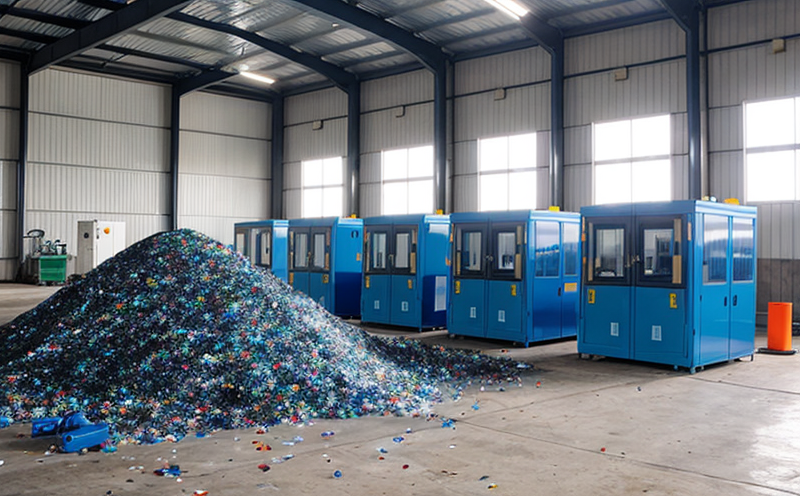ASTM D7854 Brominated Flame Retardants in Recycled Plastics
The ASTM D7854 test method is a critical tool used to determine the presence and concentration of brominated flame retardants (BFRs) in recycled plastics. This service ensures that plastic materials comply with regulatory standards, support product safety, and maintain environmental integrity during reprocessing.
Brominated flame retardants are commonly added to thermoplastics, such as polyvinyl chloride (PVC), polystyrene, and polyethylene, to enhance their fire resistance. However, when these plastics enter the recycling stream, it is essential to identify any residual BFRs that may be present in the recycled materials. The presence of BFRs can impact downstream processes and product performance if not properly controlled.
The ASTM D7854 test method provides a standardized procedure for extracting and quantifying BFRs from recycled plastics using either Soxhlet extraction or microwave-assisted extraction followed by gas chromatography with mass spectrometry (GC-MS) detection. This approach allows laboratories to accurately measure the concentration of various BFR species, such as decabromodiphenylether (Deca-BDE), octabromodiphenylether (Octa-BDE), and hexabromocyclodecane (HBCD).
The test results from ASTM D7854 are crucial for several reasons:
- Ensuring compliance with national and international regulations.
- Guaranteeing product safety by preventing the transfer of harmful substances into consumer products.
- Maintaining environmental sustainability by avoiding the release of hazardous chemicals during recycling processes.
In addition to regulatory compliance, ASTM D7854 testing is essential for quality assurance and process control in manufacturing. By monitoring BFR levels in recycled plastics, manufacturers can optimize their waste management strategies and ensure consistent product quality across batches.
| Test Parameters | Methodology |
|---|---|
| Brominated flame retardants extraction | Soxhlet or microwave-assisted extraction followed by GC-MS detection |
| Species identification | Gas chromatography with mass spectrometry (GC-MS) |
The ASTM D7854 test method is widely recognized and used in industries that handle recycled plastics, including automotive, electronics, construction, and packaging. By leveraging this service, businesses can confidently source high-quality recycled materials while adhering to stringent quality control measures.
Customer Impact and Satisfaction
The ASTM D7854 test method plays a vital role in ensuring the quality of recycled plastics used across various industries. By providing accurate data on BFR concentrations, this service helps customers:
- Avoid regulatory penalties associated with non-compliance.
- Ensure product safety and prevent potential health risks to end-users.
- Promote environmental sustainability by minimizing the release of hazardous chemicals into the environment.
Customer satisfaction is a top priority for our laboratory. Our team of experts ensures that every test conducted meets or exceeds industry standards, providing clients with reliable data and actionable insights. This commitment to excellence has earned us a reputation as a trusted partner in waste management and recycling testing.
We work closely with our customers to understand their specific needs and challenges, offering tailored solutions and support throughout the testing process. Our experienced team of chemists and engineers is dedicated to delivering accurate, timely results that help clients make informed decisions about their materials and processes.
Environmental and Sustainability Contributions
The ASTM D7854 test method contributes significantly to environmental sustainability by helping businesses recycle plastics more effectively. By identifying the presence of BFRs in recycled plastics, this service enables companies to:
- Optimize waste management strategies.
- Reduce the use of virgin materials in production processes.
- Decrease the overall environmental impact associated with plastic waste.
Our laboratory is committed to promoting environmentally responsible practices through our testing services. We believe that by providing accurate and reliable data, we can help businesses make informed decisions that benefit both their operations and the environment.
We also offer additional services related to waste management and recycling, such as trace element analysis and heavy metal detection. These complementary tests further enhance our customers' ability to manage their materials sustainably while ensuring compliance with relevant regulations.
Use Cases and Application Examples
| Use Case | Description |
|---|---|
| Recycling facility quality control | Ensure that recycled plastics meet the required BFR concentration limits. |
| Supply chain management | Evaluate the quality of plastic materials sourced from different suppliers. |
| New product development | Test new formulations for their compatibility with recycled content. |
ASTM D7854 testing is also applicable in various industries, including automotive, electronics, and construction. For instance:
- In the automotive industry: Ensuring that recycled plastics used in vehicle interiors do not contain harmful BFRs.
- In the electronics sector: Verifying that refurbished computers or other electronic devices are safe for use without exposing consumers to hazardous chemicals.
- In the construction field: Guaranteeing that reclaimed polyvinyl chloride (PVC) piping remains free from BFR contamination before installation in new structures.
These applications demonstrate the versatility and importance of ASTM D7854 testing in maintaining product safety, environmental sustainability, and regulatory compliance across multiple sectors.





